-

新人教版高中英语必修3Unit 3 Diverse Cultures教学设计三
The price is the same as(the price was)before the war.价格与战前相同。(4)定语从句中的“关系代词+助动词be”可以省略。The ticket(that/which was)booked by his sister has been sent to him.他妹妹订的那张票已送到了他那里。Step 5 PracticeActivity 3(1) Guide students to complete the four activities in the Using Structures part of exercise book, in which activities 1 and 2 focus on ellipsis in dialogue answers, activity 3 focus on signs and headlines, two typical situations where ellipsis is used, and activity 4 focus on ellipsis in diary, an informal style.(2) Combine the examples in the above activities, ask students to summarize the omitted situations in groups, and make their own summary into a poster, and post it on the class wall after class to share with the class.(This step should give full play to the subjectivity of students, and teachers should encourage students to conclude different ellipsis phenomena according to their own understanding, they can conclude according to the different parts omitted in the sentence.)Step 6 Homework1. Understand and master the usages of ellipsis;2. Finish the other exercises in Using structures of Workbook.1、通过本节内容学习,学生是否理解和掌握省略的用法;2、通过本节内容学习,学生能否根据上下文语境或情景恢复句子中省略的成分,体会使用省略的效果;3、通过本节内容学习,学生能否独立完成练习册和导学案中的相关练习。

新人教版高中英语必修3Unit 3 Diverse Cultures教学设计二
(2)Consolidate key vocabulary.Ask the students to complete the exercises of activity 6 by themselves. Then ask them to check the answers with their partners.(The first language:Damage of the 1906 San Francisco earthquake and fire.A second language: Yunnan - one of the most diverse provinces in China).Step 5 Language points1. The teacher asks the students to read the text carefully, find out the more words and long and difficult sentences in the text and draw lines, understand the use of vocabulary, and analyze the structure of long and difficult sentences.2. The teacher explains and summarizes the usage of core vocabulary and asks the students to take notes.3. The teacher analyzes and explains the long and difficult sentences that the students don't understand, so that the students can understand them better.Step 6 Homework1. Read the text again, in-depth understanding of the text;2. Master the use of core vocabulary and understand the long and difficult sentences.3. Complete relevant exercises in the guide plan.1、通过本节内容学习,学生是否理解和掌握阅读文本中的新词汇的意义与用法;2、通过本节内容学习,学生能否结合文本特点了解文章的结构和作者的写作逻辑;3、通过本节内容学习,学生能否了解旧金山的城市风貌、文化特色,以及加利福尼亚州的历史,体会多元文化对美国的影响。

新人教版高中英语必修3Unit 3 Diverse Cultures教学设计四
该板块的活动主题是“介绍一个有显著文化特征的地方”( Describe a place with distinctive cultural identity)。该板块通过介绍中国城继续聚焦中国文化。本单元主题图呈现的是旧金山中国城的典型景象, Reading and Thinking部分也提到中国城,为该板块作铺垫。介绍中国城的目的主要是体现中国文化与美国多元文化的关系,它是美国多元文化的重要组成部分。中国城也是海外华人的精神家园和传播中国文化的重要窗口,外国人在中国城能近距离体验中国文化。1. Read the text to understand the cultural characteristics of Chinatown in San Francisco and the relationship between Chinese culture and American multiculturalism;2. Through reading, learn to comb the main information of the article, understand the author's writing purpose and writing characteristics;3. Learn to give a comprehensive, accurate, and organized description of the city or town you live in;Learn to revise and evaluate your writing.Importance:1. Guide the students to read the introduction of Chinatown in San Francisco and grasp its writing characteristics;2. Guide students to introduce their city or town in a comprehensive, accurate and organized way;3. Learn to comb the main information of the article, understand the author's writing purpose, and master the core vocabulary.

新人教版高中英语必修3Unit 3 Diverse Cultures教学设计一
Activity 81.Grasp the main idea of the listening.Listen to the tape and answer the following questions:Who are the two speakers in the listening? What is their relationship?What is the main idea of the first part of the listening? How about the second part?2.Complete the passage.Ask the students to quickly review the summaries of the two listening materials in activity 2. Then play the recording for the second time.Ask them to complete the passage and fill in the blanks.3.Play the recording again and ask the students to use the structure diagram to comb the information structure in the listening.(While listening, take notes. Capture key information quickly and accurately.)Step 8 Talking Activity 91.Focus on the listening text.Listen to the students and listen to the tape. Let them understand the attitudes of Wu Yue and Justin in the conversation.How does Wu Yue feel about Chinese minority cultures?What does Justin think of the Miao and Dong cultures?How do you know that?2.learn functional items that express concerns.Ask students to focus on the expressions listed in activity. 3.And try to analyze the meaning they convey, including praise (Super!).Agree (Exactly!)"(You're kidding.!)Tell me more about it. Tell me more about it.For example, "Yeah Sure." "Definitely!" "Certainly!" "No kidding!" "No wonder!" and so on.4.Ask the students to have conversations in small groups, acting as Jsim and his friends.Justin shares his travels in Guizhou with friends and his thoughts;Justin's friends should give appropriate feedback, express their interest in relevant information, and ask for information when necessary.In order to enrich the dialogue, teachers can expand and supplement the introduction of Miao, dong, Lusheng and Dong Dage.After the group practice, the teacher can choose several groups of students to show, and let the rest of the students listen carefully, after listening to the best performance of the group, and give at least two reasons.
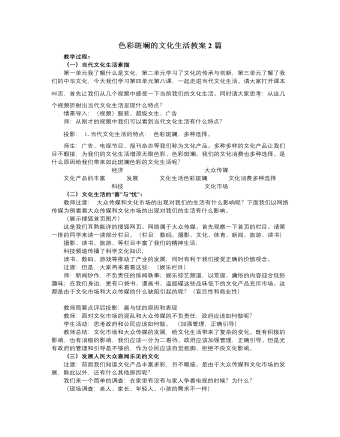
人教版高中政治必修3色彩斑斓的文化生活教案2篇
六、学习效果评价设计1、评价方式:我对学习效果的评价,来自两个方面。一是教师的教授是否认真、严肃、科学;二是学生的学习成果如何,是否达成了事先预设的教学目标,是否在学习过程中有提高的过程。评价的方式有:同伴评价;教师自我评价和反思;学生反馈。2、评价量规:我设置了几个问题用于课后的教学评价:(1)教学目标是否符合课标要求,是否符合三贴近原则,是否体现学生学习效果的生成性和过程性。(2)学习所用资源是否来自生活实际,是否真实,是否是学生感兴趣的问题。(3)教师在课堂教学过程中是否能有效的通过提问和资料的展示分析,引导学生自己生成思考过程,而不是“教师代替学生的思考”。(4)学生参与的广度和态度,学生是否提出有意义的观点和问题。学生的回答是否是实话。
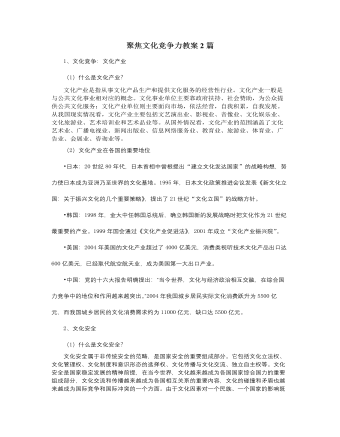
人教版高中政治必修3聚焦文化竞争力教案2篇
教学目的:通过学生课前收集资料、课堂展示、小组讨论及教师总结和讲解等形式,明确文化竞争力在国际竞争中的地位,感受各国各国日益激烈的文化竞争力,探讨如何提升中国特色社会主义文化的竞争力,培养学生的分析解决问题的能力,增强责任意识、科技意识和成才意识。教学时间:1小时课前准备:(1)学生分组收集美国、日本、英国等国家文化产业的发展状况和中国文化走向世界的资料,并要求制成简单的课件。(2)分组讨论课本P23—25的三个探究问题(①运用这些资料,从物质和精神两个方面,说明发展文化有什么意义。②你还能从社会生活的哪些现象中感受到一个国家的文化竞争力?③今天,中国文化为什么能够在世界各地赢得尊重与喝彩?),组长整理好讨论结果。
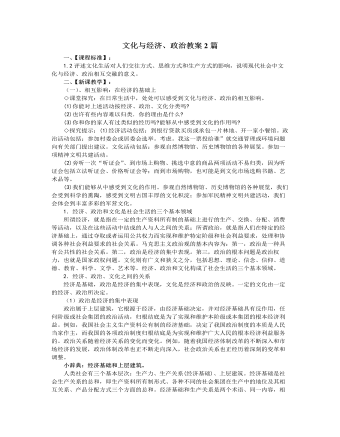
人教版高中政治必修3文化与经济、政治教案2篇
1.在激烈的国际竞争中,美国为首“巴统”在对中国出口高科技产品的问题上采取了种种限制措施,以避免西方发达国家的高科技技术和设备流人中国。面对发达国家的技术封锁,我们应该( )A.加速我国对外开放的步伐B.尽快改善与西方发达国家的关系C.努力提高自身的科技水平,增强本国的综合国力D.立足于自力更生,努力开发所有的高科技技术,以免受制于人答案:C解析:在当今和未来的世界,经济是基础,科技是龙头。因而,发展经济和科学技术是世界大多数国家最关心的问题。各国之间的竞争越来越多地转向经济和科技领域。各国都已经清楚地认识到,能否在科技发展上取得优势,增强以经;济和科技为基础的综合国力,最终将决定本国在国际上的地位。受各种主客观条件的限制,任何国家都不可能开发出自己所需要的所有技术,国家之间必须加强技术交流,互通有无,共同发展。“巴统”对我国进行技术出口方面的限制是基于其敌视中国的战略需要。为了打破西方国家的对我国的技术限制,我国必须从自身出发,提高自身的科技水平。
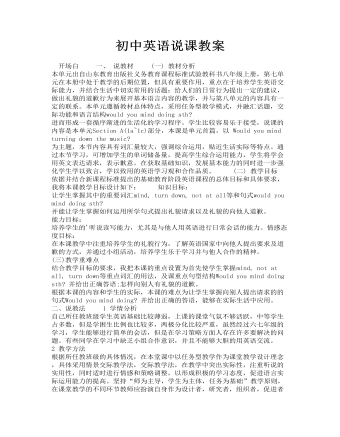
初中英语说课教案
(二) 教学目标 依据并结合新课程标准提出的基础教育阶段英语课程的总体目标和具体要求,我将本课教学目标设计如下: 知识目标: 让学生掌握其中的重要词汇mind, turn down, not at all等和句式would you mind doing sth? 并能让学生掌握如何运用所学句式提出礼貌请求以及礼貌的向他人道歉。

新人教版高中英语必修3Unit 2 Morals and Virtues-Discovering Useful Structure教学设计
1. 表示时间。Hearing these stories, I’m skeptical about the place. = When I heard these stories. . . 2. 表示原因。Not knowing his address, I can’t send this book to him. = Because/Since/As I don’t know his address. . . 3. 表示结果。His father died, leaving him a lot of money. =. . . and left him a lot of money4. 表示条件。Going straight down the road, you will find the department store. = If you go straight down the road. . . 5. 表示让步。Being tired, they went on working. =Although they were tired. . . 6. 表示行为方式、伴随情况或补充说明。He lay on the grass, staring at the sky for a long time. =. . . and stared at the sky for a long time注意:非谓语动词作状语时, 如所提供的动词不能和句子中的主语保持一致, 动词-ing形式必须有自己的逻辑主语, 通常由名词或代词来担任, 这就是独立主格结构。The last bus having gone, we had to walk home. (having gone的逻辑主语是the last bus, 而不是we)Weather permitting, the football match will be played on Friday. (permitting的逻辑主语是time, 而不是the football match)Step 7 Practice1. ________(study) hard, you are sure to get first prize. 2. People use plastic in their daily life, _______(leave) large amounts of waste. 3. ________(work) hard at your lessons, you are to succeed. 4. The old man, ____________(work) abroad for twenty years, is on the way back to his motherland. 5. ______________(finish) his homework, he was playing on the playground. Answers: 1. Studying 2. leaving 3. Working 4.having worked 5. Having finishedStep 8 HomeworkFinish the homework on Page 22.
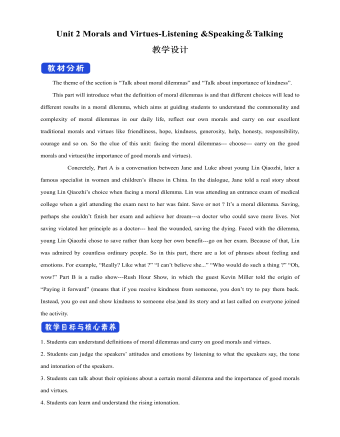
新人教版高中英语必修3Unit 2 Morals and Virtues-Listening &Speaking&Talking教学设计
Example:One day, a poor boy who was trying to pay his way through school by sending newspapers door to door found that he only had one dime(一角)left. He was so hungry that he decided to beg for a meal at the next house.However, he lost his nerve when a lovely young woman opened the door. Instead of a meal he asked for a drink of water. She thought he looked hungry so she brought him a large glass of milk. He drank it slowly, and then asked, “How much do I owe you?” “You don’t owe me anything,” she replied, “Mother has taught me never to accept pay for a kindness.” “Then I thank you from the bottom of my heart.” With these words, Howard Kelly left that house.Years later the woman became badly ill and was finally sent to the hospital in a big city. Dr. Howard Kelly, now famous, was called in. When he heard the name of the town she came from, a strange light filled his eyes. Dressed in his doctor’s clothes, Dr. Kelly went into her room and recognized her at once. From that day on, he gave special attention to her, and decided to do his best to save her life.At last the woman was saved. Dr. Kelly asked the business office to pass the final bill to him. He looked at it and then wrote something on the side. The bill was sent to the woman’s room. She was afraid to open it because she was sure that it would take the rest of her life to pay for it off. Finally she looked, and the note on the side of the bill caught her attention. She read these words: “Paid in full with a glass of milk, Dr. Howard Kelly.” Tear of joy flooded her eyes.
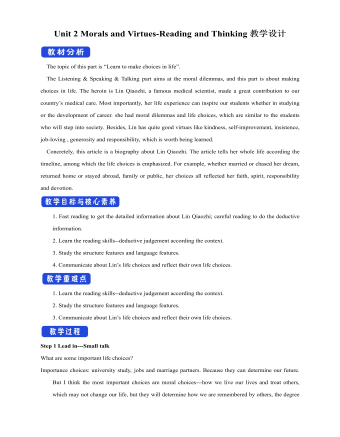
新人教版高中英语必修3Unit 2 Morals and Virtues-Reading and Thinking教学设计
The topic of this part is “Learn to make choices in life”.The Listening & Speaking & Talking part aims at the moral dilemmas, and this part is about making choices in life. The heroin is Lin Qiaozhi, a famous medical scientist, made a great contribution to our country’s medical care. Most importantly, her life experience can inspire our students whether in studying or the development of career. she had moral dilemmas and life choices, which are similar to the students who will step into society. Besides, Lin has quite good virtues like kindness, self-improvement, insistence, job-loving , generosity and responsibility, which is worth being learned.Concretely, this article is a biography about Lin Qiaozhi. The article tells her whole life according the timeline, among which the life choices is emphasized. For example, whether married or chased her dream, returned home or stayed abroad, family or public, her choices all reflected her faith, spirit, responsibility and devotion.1. Fast reading to get the detailed information about Lin Qiaozhi; careful reading to do the deductive information.2. Learn the reading skills--deductive judgement according the context.3. Study the structure features and language features. 4. Communicate about Lin’s life choices and reflect their own life choices.1. Learn the reading skills--deductive judgement according the context.2. Study the structure features and language features.3. Communicate about Lin’s life choices and reflect their own life choices.Step 1 Lead in---Small talkWhat are some important life choices?Importance choices: university study, jobs and marriage partners. Because they can determine our future.
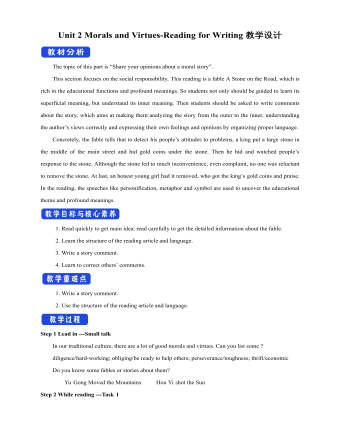
新人教版高中英语必修3Unit 2 Morals and Virtues-Reading for Writing教学设计
1. 这个寓言是一个关于一位国王古寓言。 The fable is an old fable about a king.2.作者用这个故事让读者对于社区的问题负有个人责任的必要印象深刻。The author used the story to impress upon readers with the need to take personal responsibility for problems in the community.3. 这个故事十分成功的实现了它的目的。The story was quite successful in achieving its purpose.Step 7 WritingPlease write a review of the story according the outline above.The fable is an old fable about a king who thought his people are lazy, so he put a large stone in the middle of the road and hides and waited to see if anyone will try to move it.The author used this story to impress upon readers with the need to take personal responsibility for problems in the community. The story was quite successful in achieving its purpose, and I liked it because it had a clear moral.However, while the moral of the story is clear, the actions of the king seemed pointless to me, because none of the characters in the story learnt anything. For this reason, I think there are better stories that can be used to impress upon people with the need for personal responsibility.Step 8 Pair workExchange drafts with a partner. Use this checklist to help your partner revise his/her draft.1. Does the writer give a short description of the story ?2. Does the description include the most important details of the story ?3. Does the writer give his or her opinion about the character or their actions ?4. Is the review well-organised ? 5. Does the writer use the -ing form as the adverbial correctly in the writing ?6. Are there any grammar, spelling, or punctuation errors ?Step 9 HomeworkPut up your revised draft in the classroom or read it to your class.
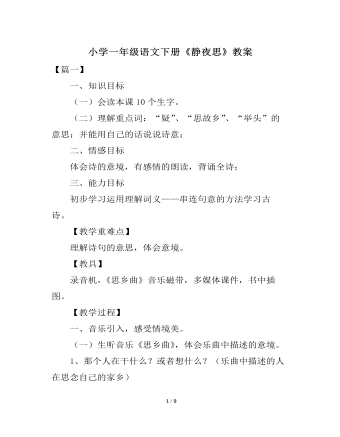
《静夜思》教案
(1)读整行诗。 (2)根据学生提出的问题理解“疑”的意思(怀疑、好像); “霜”(老师哈气在眼镜片上,并解释这是雾水,如果是冰粒,便是霜。霜在秋冬季节形成在地面附近:如房顶、草叶、地面等,堆起来是白色。) (3)说说这两行诗的意思。用上“什么好像是什么”的句式。(明亮的月光照在诗人的床前,好象是铺在地上的白白的霜) (4)朗读,引导。 诗人这样描写,给了你一种什么样的感觉?(冷清) 师描述:今晚,银白色的月光洒在地上,像铺了一层冰冷的霜一样。环境如此冷清,再加上诗人远离亲人的孤独,就更感到冷清了。
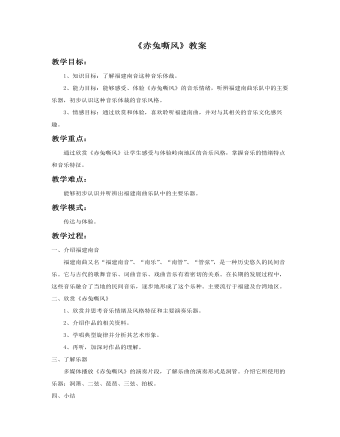
《赤兔嘶风》教案
一、介绍福建南音福建南曲又名“福建南音”、“南乐”、“南管”、“管弦”,是一种历史悠久的民间音乐。它与古代的歌舞音乐、词曲音乐、戏曲音乐有着密切的关系。在长期的发展过程中,这些音乐融合了当地的民间音乐,逐步地形成了这个乐种。主要流行于福建及台湾地区。二、欣赏《赤兔嘶风》1、欣赏并思考音乐情绪及风格特征和主要演奏乐器。2、介绍作品的相关资料。3、学唱典型旋律并分析其艺术形象。4、再听,加深对作品的理解。三、了解乐器多媒体播放《赤兔嘶风》的演奏片段,了解乐曲的演奏形式是洞管。介绍它所使用的乐器:洞箫、二弦、琵琶、三弦、拍板。
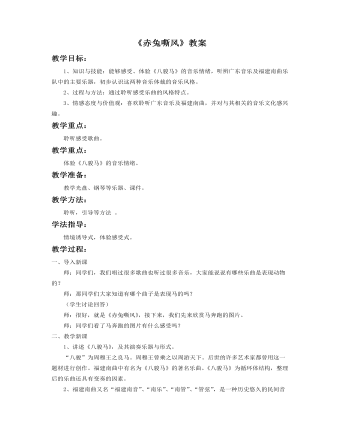
《赤兔嘶风》教案
一、导入新课师:同学们,我们唱过很多歌曲也听过很多音乐,大家能说说有哪些乐曲是表现动物的?师:那同学们大家知道有哪个曲子是表现马的吗?(学生讨论回答)师:很好,就是《赤兔嘶风》,接下来,我们先来欣赏马奔跑的图片。师:同学们看了马奔跑的图片有什么感受吗?二、教学新课1、讲述《八骏马》,及其演奏乐器与形式。 “八骏”为周穆王之良马。周穆王曾乘之以周游天下。后世的许多艺术家都曾用这一题材进行创作。福建南曲中有名为《八骏马》的著名乐曲。《八骏马》为循环体结构,整理后的乐曲还具有变奏的因素。2、福建南曲又名“福建南音”、“南乐”、“南管”、“管弦”,是一种历史悠久的民间音乐。它与古代的歌舞音乐、词曲音乐、戏曲音乐有着密切的关系。在长期的发展过程中,这些音乐融合了当地的民间音乐,逐步地形成了这个乐种。南曲包括了“指”、“谱”、“曲”三大部分。“指”是一种套曲;“谱”是有标题的器乐套曲;“曲”是有唱词的散曲,只唱不说。南曲的演奏形式有“上四管”、“下四管”之分。上四管以洞箫为主,叫做“洞管”;以笛子为主的叫做“品管”。
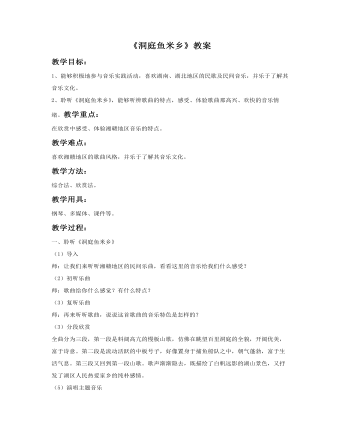
《洞庭鱼米乡》教案
一、聆听《洞庭鱼米乡》 (1)导入 师:让我们来听听湘赣地区的民间乐曲,看看这里的音乐给我们什么感受? (2)初听乐曲 师:歌曲给你什么感觉?有什么特点? (3)复听乐曲 师:再来听听歌曲,说说这首歌曲的音乐特色是怎样的?(3)分段欣赏全曲分为三段,第一段是料阔高亢的慢板山歌,仿佛在眺望百里洞庭的全貌,开阔优美,富于诗意。第二段是流动活跃的中板号子,好像置身于捕鱼船队之中,朝气蓬勃,富于生活气息。第三段又回到第一段山歌。歌声渐渐隐去,既描绘了白帆远影的湖山景色,又抒发了湖区人民热爱家乡的纯朴感情。(5)演唱主题音乐
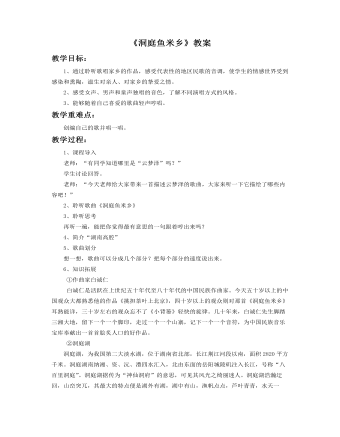
《洞庭鱼米乡》教案
知识拓展①作曲家白诚仁白诚仁是活跃在上世纪五十年代至八十年代的中国民族作曲家。今天五十岁以上的中国观众大都熟悉他的作品《挑担茶叶上北京》,四十岁以上的观众则对那首《洞庭鱼米乡》耳熟能详,三十岁左右的观众忘不了《小背篓》轻快的旋律。几十年来,白诚仁先生脚踏三湘大地,留下一个一个脚印,走过一个一个山寨,记下一个一个音符,为中国民族音乐宝库奉献出一首首脍炙人口的好作品。 ②洞庭湖洞庭湖,为我国第二大淡水湖,位于湖南省北部,长江荆江河段以南,面积2820平方千米。洞庭湖南纳湘、资、沅、澧四水汇入,北由东面的岳阳城陵矶注入长江,号称“八百里洞庭”。洞庭湖据传为“神仙洞府”的意思,可见其风光之绮丽迷人。洞庭湖浩瀚迂回,山峦突兀,其最大的特点便是湖外有湖,湖中有山,渔帆点点,芦叶青青,水天一色。
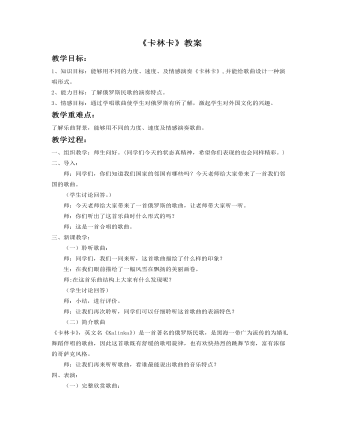
《卡林卡》教案
教学过程:一、组织教学:师生问好。(同学们今天的状态真精神,希望你们表现的也会同样精彩。)二、导入:师:同学们,你们知道我们国家的邻国有哪些吗?今天老师给大家带来了一首我们邻国的歌曲。(学生讨论回答。)师:今天老师给大家带来了一首俄罗斯的歌曲,让老师带大家听一听。师:你们听出了这首乐曲时什么形式的吗? 师:这是一首合唱的歌曲。三、新课教学: (一)聆听歌曲: 师:同学们,我们一同来听,这首歌曲描绘了什么样的印象? 生:在我们眼前描绘了一幅风雪在飘扬的美丽画卷。师:在这首乐曲结构上大家有什么发现呢?(学生讨论回答) 师:小结,进行评价。 师:让我们再次聆听,同学们可以仔细聆听这首歌曲的表演特色?
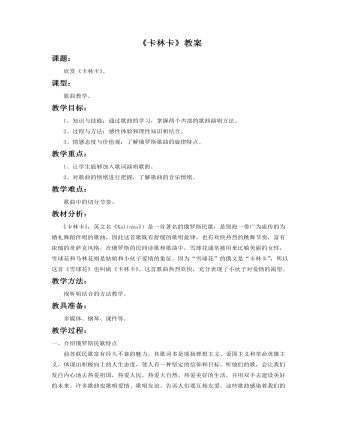
《卡林卡》教案
教学重点:1、让学生能够加入歌词演唱歌曲。2、对歌曲的情绪进行把握,了解歌曲的音乐情绪。教学难点:歌曲中的切分节奏。教材分析:《卡林卡》,英文名《Kalinka》)是一首著名的俄罗斯民歌,是黑海一带广为流传的为婚礼舞蹈伴唱的歌曲,因此这首歌既有舒缓的歌唱旋律,也有欢快热烈的跳舞节奏,富有浓郁的哥萨克风格。在俄罗斯的民间诗歌和歌曲中,雪球花通常被用来比喻美丽的女性,雪球花和马林花则是姑娘和小伙子爱情的象征。因为“雪球花”的俄文是“卡林卡”,所以这首《雪球花》也叫做《卡林卡》。这首歌曲热烈欢快,充分表现了小伙子对爱情的渴望。
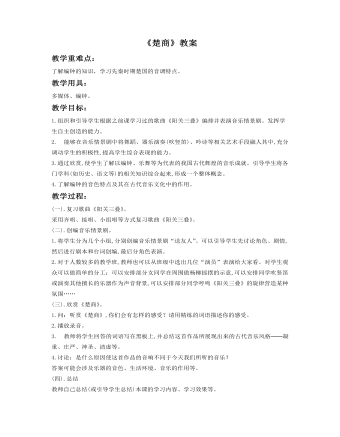
《楚商》教案
(一).复习歌曲《阳关三叠》。采用齐唱、接唱、小组唱等方式复习歌曲《阳关三叠》。(二).创编音乐情景剧。1.将学生分为几个小组,分别创编音乐情景剧“送友人”。可以引导学生先讨论角色、剧情,然后进行剧本和台词创编,最后分角色表演。2.对于人数较多的教学班,教师也可以从班级中选出几位“演员”表演给大家看。对学生观众可以做简单的分工:可以安排部分女同学在周围做杨柳摇摆的示意,可以安排同学吹竖笛或演奏其他擅长的乐器作为声音背景,可以安排部分同学哼鸣《阳关三叠》的旋律营造某种氛围……(三).欣赏《楚商》。1.问:听赏《楚商》,你们会有怎样的感受?请用精练的词语描述你的感受。2.播放录音。3. 教师将学生回答的词语写在黑板上,并总结这首作品所展现出来的古代音乐风格──凝重、庄严、神圣、清虚等。